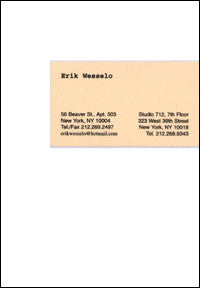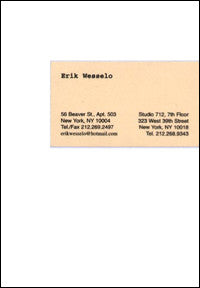Your cart is currently empty!
Photography
56 Beaver Str.
+++Erik Wesselo+++
+++Erik Wesselo i.c.w. J.M. Edwards+++
978-90-5973-056-4 [episode]
Floor Koomen
224
21 x 14
doublepaperback
English
This publication has in part been made possible through the generous support of the Netherlands Foundation for Visual Arts, Design and Architecture, the Mondriaan Foundation, Amsterdam, and drukkerij Mart Spruijt bv.
Artist Erik Wesselo lived in New York from January 2001 to April 2002. His address was 56 Beaver Street.This publication is an initial product of the 56 Beaver St. project. The book is in two parts, each based on the same principle, yet each developing a separate logic of its own. The two parts are mutually complementary.
The visual section of the book includes drawings, photographs, documents, letters, notes and other material that Wesselo kept as evidence of his stay. All this material is ordered and arranged in such a way that it now tells a tale that is no longer biographical. It is a remembrance of life as it happened there, and the images give us an idea of that life. The documents bear witness to moments of contact between people, when attempts were made to communicate, to reach one another, to reach a hand out to someone, to mean something to one another. They are all signs of love and humanity, letting people see that there are others who care about you. But in them, we also feel the reverse - being irrevocably thrown back onto oneself, onto one's own resources.
In the text section of the book, written by JM Edwards, the protagonist in the visual section is given a name, or at least a nickname: Pro. Pro is someone who gets tangled up in all kinds of situations, has all kinds of experiences, makes choices, or indeed avoids making choices. He is someone with a character and a world view of his own. The scenario is based on Erik Wesselo's stories. Edwards absorbed these tales, followed Wesselo's thinking and tried to penetrate the psyche of an artist who goes to America, with perhaps a lot of expectations, but with no clear objective in mind. If there had indeed been an objective, it quickly vanished on the horizon of the realities of everyday life, making way for more fundamental motivations and basic passions of existence. The more the story deve
In 56 Beaver St., the disappearing of the magic of the metropolis is tangible. The freedom that it can offer - being absorbed into anonymity with a future filled with plans - is replaced by an image of outcasts and people who have given up before their time, people who no longer cherish any hope. This book was made for them.
JonMarc Edwards is a self-motivated artist who has lived in Los Angeles for the last fifteen years, but spent a good deal of his youth traveling from rural to urban settings in and around the Midwest of the United States.
Edwards studied at the Museum Art School, Portland, Oregon and the Minneapolis College of Art and Design in Minnesota. He is the recipient of numerous grants, awards and commissions including the Louis Comfort Tiffany Foundation - NYC, Bush Foundation Artist Fellowship - Minneapolis, MN, the Jerome Foundation - St. Paul, Mn and the Neiman-Marcus Collection - Dallas, TX
His work has been the subject of individual exhibitions, including Raw Raw Boom Boom at the Carl Berg Gallery in Los Angeles, 'Nature's Twist', organized by Art Affairs Gallery, Amsterdam, Netherlands and is currently participating in a survey exhibition of language and idea art, Word curated by L. Brandon Krall at the Deborah Colton Gallery in Houston, Texas.
Trained as a painter with a background in filmmaking, Edwards is best known for his original and ambitious use of text as image. He compresses the attributes of text into highly emotive and legible hieroglyphics or 'characters'. Edwards uncompromising diligence and passion has led him into a concentric reverberating exploration between 'what can be said' and 'what can only be acted upon'.
Erik Wesselo
€29.50
56 Beaver Str.
Erik Wesselo
€29.50
978-90-5973-056-4 [episode]
Floor Koomen
224
21 x 14
doublepaperback
English
This publication has in part been made possible through the generous support of the Netherlands Foundation for Visual Arts, Design and Architecture, the Mondriaan Foundation, Amsterdam, and drukkerij Mart Spruijt bv.
Artist Erik Wesselo lived in New York from January 2001 to April 2002. His address was 56 Beaver Street.This publication is an initial product of the 56 Beaver St. project. The book is in two parts, each based on the same principle, yet each developing a separate logic of its own. The two parts are mutually complementary.
The visual section of the book includes drawings, photographs, documents, letters, notes and other material that Wesselo kept as evidence of his stay. All this material is ordered and arranged in such a way that it now tells a tale that is no longer biographical. It is a remembrance of life as it happened there, and the images give us an idea of that life. The documents bear witness to moments of contact between people, when attempts were made to communicate, to reach one another, to reach a hand out to someone, to mean something to one another. They are all signs of love and humanity, letting people see that there are others who care about you. But in them, we also feel the reverse - being irrevocably thrown back onto oneself, onto one's own resources.
In the text section of the book, written by JM Edwards, the protagonist in the visual section is given a name, or at least a nickname: Pro. Pro is someone who gets tangled up in all kinds of situations, has all kinds of experiences, makes choices, or indeed avoids making choices. He is someone with a character and a world view of his own. The scenario is based on Erik Wesselo's stories. Edwards absorbed these tales, followed Wesselo's thinking and tried to penetrate the psyche of an artist who goes to America, with perhaps a lot of expectations, but with no clear objective in mind. If there had indeed been an objective, it quickly vanished on the horizon of the realities of everyday life, making way for more fundamental motivations and basic passions of existence. The more the story deve
In 56 Beaver St., the disappearing of the magic of the metropolis is tangible. The freedom that it can offer - being absorbed into anonymity with a future filled with plans - is replaced by an image of outcasts and people who have given up before their time, people who no longer cherish any hope. This book was made for them.
JonMarc Edwards is a self-motivated artist who has lived in Los Angeles for the last fifteen years, but spent a good deal of his youth traveling from rural to urban settings in and around the Midwest of the United States.
Edwards studied at the Museum Art School, Portland, Oregon and the Minneapolis College of Art and Design in Minnesota. He is the recipient of numerous grants, awards and commissions including the Louis Comfort Tiffany Foundation - NYC, Bush Foundation Artist Fellowship - Minneapolis, MN, the Jerome Foundation - St. Paul, Mn and the Neiman-Marcus Collection - Dallas, TX
His work has been the subject of individual exhibitions, including Raw Raw Boom Boom at the Carl Berg Gallery in Los Angeles, 'Nature's Twist', organized by Art Affairs Gallery, Amsterdam, Netherlands and is currently participating in a survey exhibition of language and idea art, Word curated by L. Brandon Krall at the Deborah Colton Gallery in Houston, Texas.
Trained as a painter with a background in filmmaking, Edwards is best known for his original and ambitious use of text as image. He compresses the attributes of text into highly emotive and legible hieroglyphics or 'characters'. Edwards uncompromising diligence and passion has led him into a concentric reverberating exploration between 'what can be said' and 'what can only be acted upon'.



